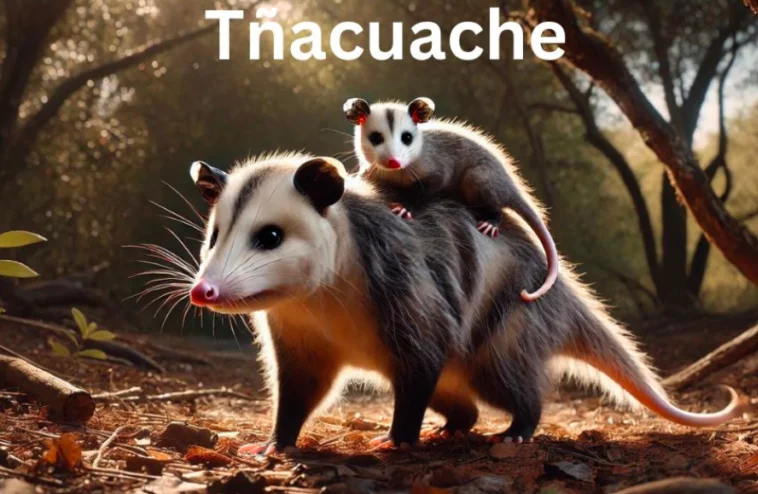Introduction: The Adventure Begins
In the heart of lush forests and vibrant landscapes, a remarkable creature roams under the cover of night: the tñacuache. This nocturnal marsupial, known for its unique appearance and intriguing behaviors, captivates those lucky enough to encounter it. Imagine wandering through the underbrush, the soft rustle of leaves heralding the arrival of this elusive animal. The tñacuache, or opossum, is not just an animal; it’s a symbol of resilience and adaptation, showcasing the wonders of nature in its rawest form.
For centuries, cultures have recognized the tñacuache as more than just a creature of the night. Folklore surrounds this intriguing animal, portraying it as clever and resourceful. Whether seen as a pest in urban areas or a valuable part of the ecosystem in rural settings, the tñacuache’s presence brings stories and lessons that resonate with many. Join me as we delve deeper into the world of the tñacuache, exploring its physical characteristics, behavior, habitat, ecological significance, and cultural importance.
What is a Tñacuache?
The tñacuache, scientifically known as Didelphis marsupialis, is a marsupial native to the Americas. Unlike other mammals, the tñacuache carries its young in a pouch, similar to kangaroos. This fascinating characteristic sets it apart from many other species in its habitat.
Physical Characteristics
- Size and Weight: The tñacuache typically weighs between 4 to 14 pounds and measures about 24 to 40 inches long, including its tail. Males tend to be larger than females, showcasing the natural variation within the species.
- Coloration: Its fur is usually gray or brown, adorned with a white face and black ears, giving it a distinctive look. The coloration helps it blend into its surroundings, an essential trait for a nocturnal creature that relies on stealth.
Unique Features
The tñacuache possesses several unique features that enhance its adaptability:
- Prehensile Tail: The tail is long and prehensile, allowing the tñacuache to grasp branches while climbing. This tail acts as an additional limb, providing balance and stability.
- Sharp Claws: Equipped with sharp claws, the tñacuache can easily climb trees and dig into the ground in search of food. Its climbing abilities make it agile in navigating its forested habitat.
Habitat and Distribution
Tñacuaches are versatile creatures, thriving in various environments, including:
- Forests: They are commonly found in tropical and subtropical forests, where dense foliage provides cover and abundant food sources.
- Grasslands: Open fields with scattered trees allow for easy movement and access to various plants and insects.
- Urban Areas: Surprisingly, tñacuaches have adapted to urban settings, often seen rummaging through gardens and trash cans in search of food. Their ability to thrive alongside humans demonstrates their resilience.
Their adaptability allows them to coexist with humans, often seen rummaging through gardens and trash cans in search of food. In some areas, people may view the tñacuache as a nuisance, but it plays a vital role in maintaining ecological balance.
Behavior and Diet of Tñacuache
Tñacuaches are primarily nocturnal, becoming active at night to search for food. They are opportunistic feeders, which means they consume whatever is available. Their diet consists of:
- Fruits: Tñacuaches are fond of fruits such as berries, apples, and grapes. Their preference for ripe fruits helps disperse seeds, contributing to forest regeneration.
- Vegetables: They will also eat vegetables, making gardens an appealing target.
- Insects: A significant part of their diet consists of insects like beetles and crickets, helping to control pest populations.
- Small Animals: Occasionally, tñacuaches will prey on small rodents, birds, and even carrion, showcasing their omnivorous nature.
Unique Defense Mechanism
One of the most fascinating aspects of the tñacuache is its defense mechanism. When threatened, this remarkable creature can “play dead.” By collapsing on its side and emitting a foul odor, it tricks predators into thinking it’s no longer a threat. This behavior not only saves its life but also highlights the tñacuache’s unique adaptation to survive in the wild.
The Process of Playing Dead
The process of playing dead is known as “playing possum.” When confronted by danger, the tñacuache goes through several stages:
- Collapse: It falls to the ground, lying still and unresponsive.
- Foul Smell: During this time, it secretes a foul-smelling liquid from its glands, which mimics the scent of decay. This scent deters predators who prefer fresh prey.
- Inactivity: The tñacuache remains in this state for an extended period, often until the threat has passed. This clever tactic allows it to escape predation and resume its normal activities.
This defense mechanism has contributed to the tñacuache’s survival for millions of years, demonstrating the effectiveness of its evolutionary adaptations.
The Role of Tñacuache in Ecosystems
The tñacuache plays a vital role in its ecosystem, acting as both a predator and prey. Its diet helps control insect populations, contributing to a balanced environment. Additionally, as scavengers, they help clean up the forest floor by consuming dead animals and decaying plant matter.
Ecological Contributions
- Pest Control: By consuming insects, the tñacuache helps control pest populations, benefiting agricultural areas and natural habitats.
- Seed Dispersal: As it eats fruits, the tñacuache aids in seed dispersal. This process is crucial for plant reproduction and maintaining healthy ecosystems.
- Nutrient Recycling: By feeding on carrion, the tñacuache plays a role in nutrient recycling, breaking down organic matter and returning essential nutrients to the soil.
Threats and Conservation
While tñacuaches are adaptable and resilient, they face several threats:
- Habitat Loss: Deforestation and urbanization lead to habitat destruction, diminishing their natural living spaces.
- Road Mortality: As they venture into urban areas, many tñacuaches fall victim to traffic, impacting local populations.
- Human Persecution: In some regions, they are viewed as pests and may be killed or removed, further threatening their survival.
Conservation efforts are essential to protect the tñacuache and its habitat. Promoting awareness about their ecological importance can help foster coexistence between humans and these remarkable creatures.
Cultural Significance
In various cultures, the tñacuache is seen as a symbol of adaptability and survival. Many Indigenous communities tell stories about this remarkable animal, teaching lessons about resilience and the importance of coexistence with nature. These tales often highlight the tñacuache’s cleverness and resourcefulness, traits that resonate with many people today.
Folklore and Myths
In many Latin American cultures, the tñacuache appears in folklore and myths. Here are a few examples:
- Trickster Tales: The tñacuache is often portrayed as a trickster figure in folk stories, using its wits to outsmart predators or other animals. These tales emphasize intelligence and adaptability, qualities admired by many cultures.
- Cultural Representations: The tñacuache is sometimes depicted in art, crafts, and festivals, showcasing its significance in cultural heritage. These representations honor the animal’s unique traits and the lessons learned from its behaviors.
Educational Importance
Understanding the cultural significance of the tñacuache fosters appreciation for biodiversity and encourages conservation efforts. Educational programs that highlight the role of the tñacuache in ecosystems can promote a deeper connection between communities and their natural surroundings.
Tñacuache in the Urban Environment
As cities expand, the tñacuache has adapted to urban life, often becoming a common sight in suburban areas. This adaptability raises questions about wildlife management and the challenges of urbanization.
Urban Adaptations
- Dietary Changes: In urban areas, tñacuaches have expanded their diets to include human food scraps. This opportunistic feeding behavior allows them to thrive in environments with limited natural food sources.
- Shelter: Tñacuaches utilize human structures for shelter, nesting in attics, basements, or under decks. Their ability to find refuge in urban settings showcases their resourcefulness.
Human-Tñacuache Interactions
While many people enjoy observing tñacuaches, others view them as pests. Understanding these interactions is crucial for promoting coexistence:
- Positive Encounters: Some urban dwellers appreciate the tñacuache for its role in pest control, noting its ability to consume insects and small rodents.
- Negative Encounters: Conversely, property damage or raiding of trash cans can lead to frustration. Education about the tñacuache’s behavior and ecological contributions can help mitigate negative perceptions.
Effective Management Strategies
To promote coexistence, cities can implement management strategies that address human-tñacuache interactions:
- Public Awareness Campaigns: Educating the public about the ecological role of tñacuaches can foster appreciation and understanding.
- Wildlife-Friendly Practices: Encouraging practices such as securing trash cans and providing wildlife corridors can help minimize conflicts.
The Future of Tñacuache
The future of the tñacuache depends on the collective efforts of communities, conservationists, and wildlife managers. As urbanization continues to encroach upon their habitats, proactive measures are necessary to ensure the survival of this remarkable marsupial.
Community Involvement
Engaging local communities in conservation efforts can lead to positive outcomes for both the tñacuache and its habitat. Community-driven initiatives, such as habitat restoration projects and awareness campaigns, can foster a sense of responsibility and stewardship toward local wildlife.
Research and Conservation
Ongoing research is crucial for understanding the tñacuache’s population dynamics and ecological role. Conservation organizations can play a vital role in monitoring populations, advocating for habitat protection, and promoting sustainable practices that benefit both humans and wildlife.
A Call to Action
As we reflect on the fascinating world of the tñacuache, it’s essential to recognize our responsibility in safeguarding its future. By promoting awareness, understanding, and respect for this remarkable creature, we can contribute to a harmonious coexistence between humans and the diverse wildlife that enriches our planet.
Conclusion: A Legacy of Resilience
The tñacuache stands as a testament to nature’s resilience and adaptability. From its unique physical characteristics to its essential role in ecosystems, this remarkable marsupial teaches us valuable lessons about survival, coexistence, and the interconnectedness of all living beings. As we move forward, let us embrace the spirit of the tñacuache, advocating for its protection and celebrating the beauty of the natural world.
Frequently Asked Questions (FAQs)
What is a tñacuache?
The tñacuache, or opossum, is a nocturnal marsupial native to the Americas, known for its unique characteristics and adaptability.
What do tñacuaches eat?
Tñacuaches are omnivorous and eat fruits, insects, small animals, and carrion, making them opportunistic feeders in their environment.
How do tñacuaches defend themselves?
When threatened, tñacuaches can play dead, emitting a foul odor to deter predators, which helps them survive encounters with danger.
What is the habitat of the tñacuache?
Tñacuaches thrive in diverse habitats, including forests, grasslands, and urban areas, showcasing their adaptability to various environments.
Are tñacuaches harmful to humans?
Tñacuaches are generally not harmful and can help control insect populations. However, they may rummage through trash in urban areas.





